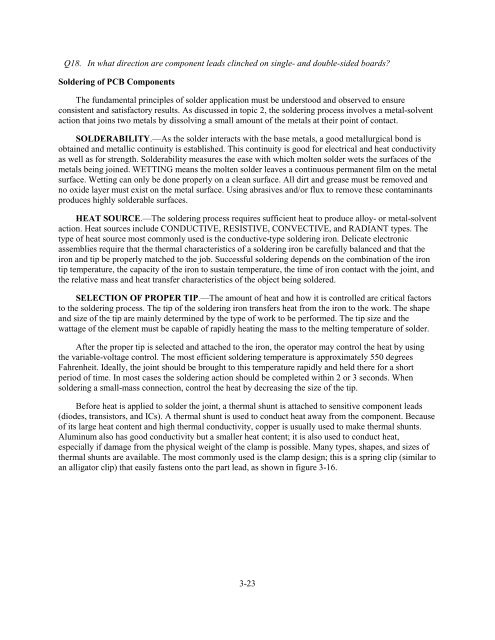Navy Electricity and Electronics Training Series - Historic Naval ...
Navy Electricity and Electronics Training Series - Historic Naval ...
Navy Electricity and Electronics Training Series - Historic Naval ...
Create successful ePaper yourself
Turn your PDF publications into a flip-book with our unique Google optimized e-Paper software.
Q18. In what direction are component leads clinched on single- <strong>and</strong> double-sided boards?Soldering of PCB ComponentsThe fundamental principles of solder application must be understood <strong>and</strong> observed to ensureconsistent <strong>and</strong> satisfactory results. As discussed in topic 2, the soldering process involves a metal-solventaction that joins two metals by dissolving a small amount of the metals at their point of contact.SOLDERABILITY.—As the solder interacts with the base metals, a good metallurgical bond isobtained <strong>and</strong> metallic continuity is established. This continuity is good for electrical <strong>and</strong> heat conductivityas well as for strength. Solderability measures the ease with which molten solder wets the surfaces of themetals being joined. WETTING means the molten solder leaves a continuous permanent film on the metalsurface. Wetting can only be done properly on a clean surface. All dirt <strong>and</strong> grease must be removed <strong>and</strong>no oxide layer must exist on the metal surface. Using abrasives <strong>and</strong>/or flux to remove these contaminantsproduces highly solderable surfaces.HEAT SOURCE.—The soldering process requires sufficient heat to produce alloy- or metal-solventaction. Heat sources include CONDUCTIVE, RESISTIVE, CONVECTIVE, <strong>and</strong> RADIANT types. Thetype of heat source most commonly used is the conductive-type soldering iron. Delicate electronicassemblies require that the thermal characteristics of a soldering iron be carefully balanced <strong>and</strong> that theiron <strong>and</strong> tip be properly matched to the job. Successful soldering depends on the combination of the irontip temperature, the capacity of the iron to sustain temperature, the time of iron contact with the joint, <strong>and</strong>the relative mass <strong>and</strong> heat transfer characteristics of the object being soldered.SELECTION OF PROPER TIP.—The amount of heat <strong>and</strong> how it is controlled are critical factorsto the soldering process. The tip of the soldering iron transfers heat from the iron to the work. The shape<strong>and</strong> size of the tip are mainly determined by the type of work to be performed. The tip size <strong>and</strong> thewattage of the element must be capable of rapidly heating the mass to the melting temperature of solder.After the proper tip is selected <strong>and</strong> attached to the iron, the operator may control the heat by usingthe variable-voltage control. The most efficient soldering temperature is approximately 550 degreesFahrenheit. Ideally, the joint should be brought to this temperature rapidly <strong>and</strong> held there for a shortperiod of time. In most cases the soldering action should be completed within 2 or 3 seconds. Whensoldering a small-mass connection, control the heat by decreasing the size of the tip.Before heat is applied to solder the joint, a thermal shunt is attached to sensitive component leads(diodes, transistors, <strong>and</strong> ICs). A thermal shunt is used to conduct heat away from the component. Becauseof its large heat content <strong>and</strong> high thermal conductivity, copper is usually used to make thermal shunts.Aluminum also has good conductivity but a smaller heat content; it is also used to conduct heat,especially if damage from the physical weight of the clamp is possible. Many types, shapes, <strong>and</strong> sizes ofthermal shunts are available. The most commonly used is the clamp design; this is a spring clip (similar toan alligator clip) that easily fastens onto the part lead, as shown in figure 3-16.3-23

















